Hunting for Diver Ducks on the Great Columbia River
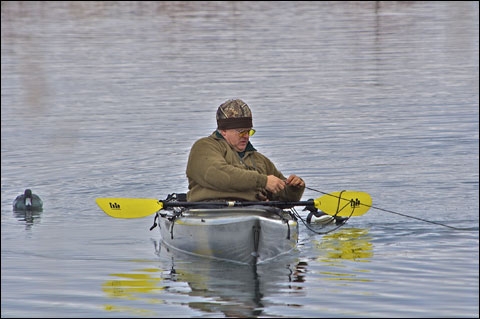
It was 7 am Monday morning in Spokane when I picked up Mark and Puck to begin the three hour drive to the portion of the Columbia we would hunt for the next two days. After loading Mark’s gear including Puck, my Tahoe was packed to the ceiling with all of the gear required to hunt ducks. Most of the gear was designed to keep our bodies as warm as possible, but as all duck hunters know, the reels of decoy lines, decoys, stools, camo, dog food, water, waders, boots and the list goes on, all just to bag a few ducks is necessary as I was to beginning to understand.
It was 7 am Monday morning in Spokane when I picked up Mark and Puck to begin the three hour drive to the portion of the Columbia we would hunt for the next two days. After loading Mark’s gear including Puck, my Tahoe was packed to the ceiling with all of the gear required to hunt ducks. Most of the gear was designed to keep our bodies as warm as possible, but as all duck hunters know, the reels of decoy lines, decoys, stools, camo, dog food, water, waders, boots and the list goes on, all just to bag a few ducks is necessary as I was to beginning to understand.
Mark, my wing shooting partner, called and offered me the opportunity to shoot one of his favorite spots on the great Columbia River in eastern Washington. We have hunted pheasants in the Dakotas, geese in Canada, huns and chukar in Idaho and Montana, but for one reason or another we had never hunted ducks together.
His amazing black lab Puck would be with us, of course. His retrievals are legendary with anyone who has had the opportunity and privilege to shoot over him and his friendly and quirky nature make him a pleasure to have around including in a motel. In the blind or on retrieve this boy is all business. His focus is unbreakable once he knows he is working.
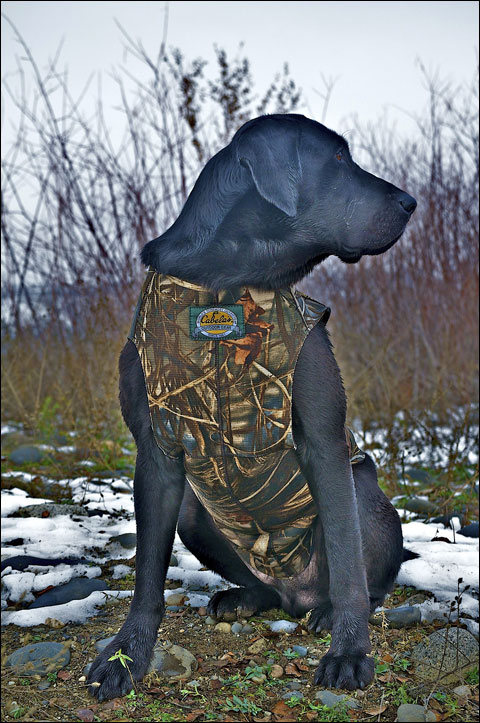
The weather was chilly with overcast skies which boded well for the ducks being on the move. Every duck hunter understands the worse the weather, the better the duck hunting. For me I prefer the warmer weather and more benign conditions enjoyed when bird hunting in the fall, but I was determined to learn all I could from Mark and his forty plus years of duck hunting all over the country. Hunting divers like bluebills (lesser scaup), cans (canvasbacks), redheads and of, hopefully, a few Widgeon, presents their own issues that are not as well understood in other parts of the country where puddle ducks such as Gadwall, Pintail, Mallards and others are the most common.
Since last year I had been a bit anxious to try out the new waders I had bought when we tried to make this trip and never could get the timing right. The trip from Spokane to the Columbia takes you through a variety of environments including long, expansive wheat fields, barren desert, small towns and hydro-electric dams that service the state. It is all two lane road so it’s a bit slow going, but in good weather it is no big deal and the time provides the opportunity to practice some duck calling, talk about ducks, dogs and guns.
For me, when Mark takes over the driving, it is also an opportunity drift off and snooze a bit and as always I pay the price with some gentle ribbing from my friend. As we get close to our destination we turn off the main road to begin the process of scouting to find out for sure just where the ducks are and what they are doing on this particular day. As we approach the Columbia I am struck by not only the beauty but the realization of what an amazing resource this is for the Pacific Northwest and how excited Lewis and Clark must have been upon their discovery of this incredible place in a land of such variety.
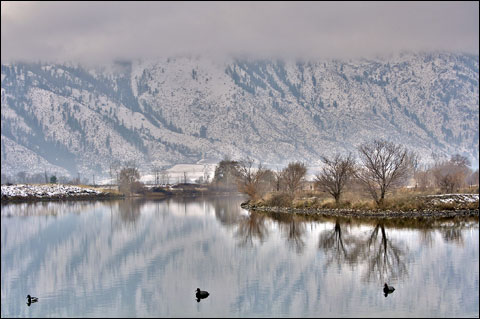
The Columbia River is one of the most dominant environmental features of the Pacific Northwest. Beginning high in the mountains of southeastern British Columbia, the Columbia River flows 2,000 kilometers (1,243 miles) through alpine and sub-alpine environments, mountain forests, lava fields, semi-arid grasslands, and low-elevation rainforests before entering the Pacific Ocean.
All duck hunters have their favorite spots and when one is invited to go along to such a place it is incumbent upon the guest to maintain the host’s secrecy, so therefore I will not be specific as to where on the Columbia we were to hunt. The photos I was able to get however are amazing and sometimes it was difficult for me to decide to hold onto my Benelli Super Sport or my Nikon.
We checked into our motel about 10:30 am and met up with another of Mark’s friends Tommy at the motel as previously arranged. Tommy had made the trip in from Seattle with his 12 ft aluminum boat and 7 hp motor squeezed into his van. Of course he was on time and we all headed out to the area to launch the boat. The plan was Mark and Tommy would load some of the gear along with Puck and head to the blind that was located on a point of land several hundred yards downriver form the launch area. I would then take the Tahoe and drive to a walk-in area closer to the blind and bring the rest of the equipment where Tommy would then pick me up in the boat and we would head out to the blind where Mark would have started setting up.
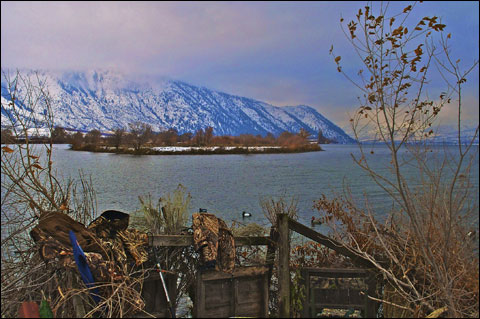
The blind offered unrestricted views of two channels of the river and for divers, if they were moving, would give us plenty of action as they would respond to Mark’s call and zoom by as they took a look at our decoys. The cloudy chilly weather with a front moving in should be just about perfect to get the ducks moving and we were determined to get set up as quickly as possible.
It was certainly clear to me that Mark’s experience and the quality of his equipment, including the lines and decoy setup, that this would be fun. The plan was for Tom to set up the decoys from his boat as Mark and I strung them onto the lines. We formed the decoys into as much of a “J” shape as possible since that’s what divers look like when rafted up together in the big water. Once the decoys were in place we didn’t have long to wait as we were treated to flights of bluebills, two to six at a time. As the day wore on we spotted the occasional canvasback and redhead and a few widgeon for good measure.
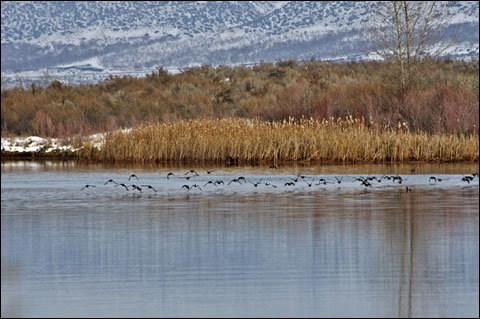
Now as a new duck hunter, I was quick to discover how much faster these guys fly as compared to upland birds. Also, divers really don’t come into decoys like puddle ducks by setting wings, feet down and drifting in slowly. They have a tendency to come in hard and fast but typically they just take a quick look and move on. If anything, diver duck hunting is more like dove hunting and pass shooting. I quickly learned that you can’t lead a diver duck too much.
Divers will on occasion turn and comeback for a second look and when called correctly will usually be closer to the decoy line. Mark’s calling ability brought them back on several occasions, which made for more shooting opportunities.
I am certainly not bragging here, but just to prove a point I went through two boxes of shells and bagged three ducks, probably somewhat because I was laughing so hard at myself. I was determined to get a better handle on this for the next day and fortunately I would. The day ended with 10 birds on the strap most of which were taken by Mark and Tommy. Happily for my first duck hunt I did bag a canvasback, the king of ducks, since the daily limit is one. We each got a canvasback this day and if nothing else went right that made it a good shoot.
In this part of Washington the limit on bluebills is three daily and based on the thousands on the Columbia it is hard to understand the reasoning for this limit here. Other parts of the country where they are not so plentiful it certainly makes sense.
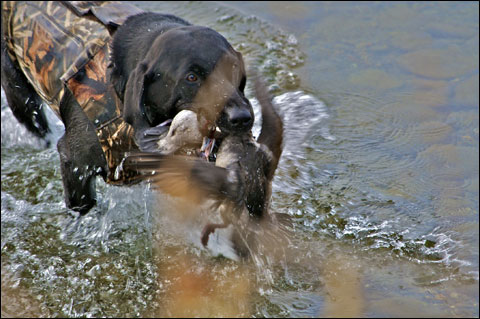
Sadly, as is common with diver ducks, a couple of cripples got away for when a diver is knocked down and not killed they can dive underwater away from the dog and surface many yards away. Puck being the intensely focused retriever would swim in circles for what seemed way too long a time in the cold water trying to find what he knew was there somewhere. Of course Puck was wearing a vest and is probably one of the best conditioned dogs around and a very powerful swimmer so Mark was not overly concerned about him trying to wait out the duck. When necessary he will certainly respond to the whistle and abandon the search and head back to the blind.
Most of the time, a diver duck will resurface well outside shotgun range, so before we picked up the decoys Tommy did go out in the boat and retrieve a couple we had kept tabs on that finally went feet up. Remember we are shooting on a river and the current does move rather quickly, so sometimes the cripples will disappear and go down river most likely to become a lucky bald eagles dinner. It becomes clear very quickly that duck hunting requires a lot of work for a few hours of actual hunting and my first experience at this told me that was just fine.

Day two brought more weather just about the same except slightly warmer temperatures which allowed the ducks to be comfortably rafted. Our plan for this day was a repeat of day one except to use fewer shells and have more ducks on the straps at day’s end. We ate a mediocre but leisurely breakfast at a nearby small town restaurant, returned to the motel for natures call, put on our waders and headed out. Logistically all went well and we were setup by 8:30 and in time for the morning parade of divers with their air acrobatics. Tommy was shooting a Model 21 that belonged to his grandfather, and in keeping with that the aluminum boat we were using also belonged to his grandfather which he has reason to believe was one of the first aluminum boats sold in Seattle long ago. Mark was shooting his Cortona O/U 12 ga (the Ugly Gun) and I had my trusty Benelli Super Sport with a choke made for steel shot. This day was a virtual carbon copy of day one except I shot better after my extensive practice on day one. We strapped another ten birds even with less traffic as the weather was getting milder and the ducks really had no pressure or need to move from wherever they chose to be.
It was about mid afternoon when we started bringing in the decoys to pack up and make the trip home. As we said good bye to the blind and I had taken my last photo in the fading light, we all spoke about the greatness of the trip and the feeling of how lucky we were to be able to enjoy this place, this sport and this time. As always the hardest working member of this party was Puck, a dog who not only is dedicated to his work, but also just clearly enjoys being out in the field with the guys that give him the opportunity to have feathers in his gentle mouth. He truly loves doing what he was bred for and his eagerness is catching. We should be so lucky to be so dedicated.
If you ever get the chance to see the Great Columbia River, do it, for it is always breathtaking, magnificent, scary, serene or angry and it pulls all sorts of emotions from those who spend time on or near it. While sitting in the blind you get to see blue herons, bald eagles and the occasional marsh hawks all of whom occupy this special place. When the water is as quiet as a mill pond the large fish can be seen surfacing to feed and turning to make large ripples in the still water. The sounds, sights and smells make you want to return soon for more days here and this is certainly now not my last duck hunt. I guess I did ok since I have been invited to do it again and I can’t wait. Maybe it’s just that I remembered to bring lunch and a thermos and that I do help with the decoys. I should also like to say how nice it was to hunt with men who have respect for the land, the sport and the ducks. Unlike some of the television shows no one yelled “Take’em.”
Al Hague is an avid outdoorsman and published author as well as outdoor photographer. Al resides and hunts mostly in the western half of the US and Canada. His photos can also be seen on http://www.shutterpoint.com and http://www.theartshop.com.

Al Hague is an avid outdoorsman and published author as well as outdoor photographer. Al resides and hunts mostly in the western half of the US and Canada. His photos can also be seen on http://www.shutterpoint.com and http://www.theartshop.com.


Comments